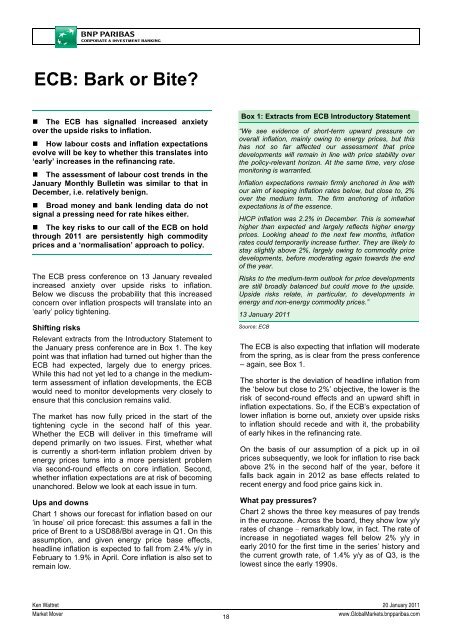Market Economics | Interest Rate Strategy - BNP PARIBAS ...
Market Economics | Interest Rate Strategy - BNP PARIBAS ...
Market Economics | Interest Rate Strategy - BNP PARIBAS ...
Create successful ePaper yourself
Turn your PDF publications into a flip-book with our unique Google optimized e-Paper software.
ECB: Bark or Bite?<br />
• The ECB has signalled increased anxiety<br />
over the upside risks to inflation.<br />
• How labour costs and inflation expectations<br />
evolve will be key to whether this translates into<br />
‘early’ increases in the refinancing rate.<br />
• The assessment of labour cost trends in the<br />
January Monthly Bulletin was similar to that in<br />
December, i.e. relatively benign.<br />
• Broad money and bank lending data do not<br />
signal a pressing need for rate hikes either.<br />
• The key risks to our call of the ECB on hold<br />
through 2011 are persistently high commodity<br />
prices and a ‘normalisation’ approach to policy.<br />
The ECB press conference on 13 January revealed<br />
increased anxiety over upside risks to inflation.<br />
Below we discuss the probability that this increased<br />
concern over inflation prospects will translate into an<br />
‘early’ policy tightening.<br />
Shifting risks<br />
Relevant extracts from the Introductory Statement to<br />
the January press conference are in Box 1. The key<br />
point was that inflation had turned out higher than the<br />
ECB had expected, largely due to energy prices.<br />
While this had not yet led to a change in the mediumterm<br />
assessment of inflation developments, the ECB<br />
would need to monitor developments very closely to<br />
ensure that this conclusion remains valid.<br />
The market has now fully priced in the start of the<br />
tightening cycle in the second half of this year.<br />
Whether the ECB will deliver in this timeframe will<br />
depend primarily on two issues. First, whether what<br />
is currently a short-term inflation problem driven by<br />
energy prices turns into a more persistent problem<br />
via second-round effects on core inflation. Second,<br />
whether inflation expectations are at risk of becoming<br />
unanchored. Below we look at each issue in turn.<br />
Ups and downs<br />
Chart 1 shows our forecast for inflation based on our<br />
‘in house’ oil price forecast: this assumes a fall in the<br />
price of Brent to a USD88/Bbl average in Q1. On this<br />
assumption, and given energy price base effects,<br />
headline inflation is expected to fall from 2.4% y/y in<br />
February to 1.9% in April. Core inflation is also set to<br />
remain low.<br />
Box 1: Extracts from ECB Introductory Statement<br />
“We see evidence of short-term upward pressure on<br />
overall inflation, mainly owing to energy prices, but this<br />
has not so far affected our assessment that price<br />
developments will remain in line with price stability over<br />
the policy-relevant horizon. At the same time, very close<br />
monitoring is warranted.<br />
Inflation expectations remain firmly anchored in line with<br />
our aim of keeping inflation rates below, but close to, 2%<br />
over the medium term. The firm anchoring of inflation<br />
expectations is of the essence.<br />
HICP inflation was 2.2% in December. This is somewhat<br />
higher than expected and largely reflects higher energy<br />
prices. Looking ahead to the next few months, inflation<br />
rates could temporarily increase further. They are likely to<br />
stay slightly above 2%, largely owing to commodity price<br />
developments, before moderating again towards the end<br />
of the year.<br />
Risks to the medium-term outlook for price developments<br />
are still broadly balanced but could move to the upside.<br />
Upside risks relate, in particular, to developments in<br />
energy and non-energy commodity prices.”<br />
13 January 2011<br />
Source: ECB<br />
The ECB is also expecting that inflation will moderate<br />
from the spring, as is clear from the press conference<br />
– again, see Box 1.<br />
The shorter is the deviation of headline inflation from<br />
the ‘below but close to 2%’ objective, the lower is the<br />
risk of second-round effects and an upward shift in<br />
inflation expectations. So, if the ECB’s expectation of<br />
lower inflation is borne out, anxiety over upside risks<br />
to inflation should recede and with it, the probability<br />
of early hikes in the refinancing rate.<br />
On the basis of our assumption of a pick up in oil<br />
prices subsequently, we look for inflation to rise back<br />
above 2% in the second half of the year, before it<br />
falls back again in 2012 as base effects related to<br />
recent energy and food price gains kick in.<br />
What pay pressures?<br />
Chart 2 shows the three key measures of pay trends<br />
in the eurozone. Across the board, they show low y/y<br />
rates of change – remarkably low, in fact. The rate of<br />
increase in negotiated wages fell below 2% y/y in<br />
early 2010 for the first time in the series’ history and<br />
the current growth rate, of 1.4% y/y as of Q3, is the<br />
lowest since the early 1990s.<br />
Ken Wattret 20 January 2011<br />
<strong>Market</strong> Mover<br />
18<br />
www.Global<strong>Market</strong>s.bnpparibas.com

















